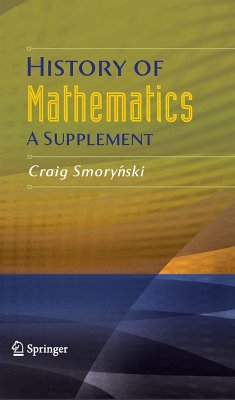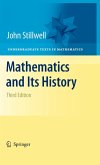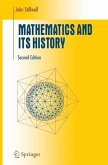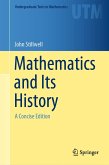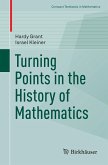This book attempts to fill two gaps which exist in the standard textbooks on the History of Mathematics. One is to provide students with material that could encourage more critical thinking. General textbooks, attempting to cover three thousand years of mathematical history, must necessarily oversimplify almost everything, the practice of which can scarcely promote a critical approach to the subject. For this reason, Craig Smorynski chooses a more narrow but deeper coverage of a few select topics.
The second aim of this book is to include the proofs of important results which are typically neglected in the modern history of mathematics curriculum. The most obvious of these is the oft-cited necessity of introducing complex numbers in applying the algebraic solution of cubic equations. This solution, though it is now relegated to courses in the History of Mathematics, was a major occurrence in the history of mathematics. It was the first substantial piece of mathematics in Europe that was not a mere extension of what the Greeks had done and thus signified the coming of age of European mathematics. The fact that the solution, in the case of three distinct real roots to a cubic, necessarily involved complex numbers both made inevitable the acceptance and study of these numbers and provided a stimulus for the development of numerical approximation methods.
Other unique features include:
* a prefatory essay on the ways in which sources may be unreliable, followed by an annotated bibliography;
* a modern recounting of a Chinese word problem from the 13th century, illustrating the need for consulting multiple sources when the primary source is unavailable;
* the solution of the cubic equation, including multiple proofs that the algebraic solution uses complex numbers whenever the cubic equation has three distinct real solutions;
* a critical reappraisal of Horner's Method;
The final chapter contains lighter material, including a critical look at North Korea's stamps commemorating the 350th birthday of Newton, historically interesting (and hard to find) poems, and drinking songs or limericks with mathematical themes. The appendix outlines a few, small projects which could serve as replacements for the usual term papers.
Craig Smorynski is also the author of "Self-Reference and Modal Logic" and "Logical Number Theory I".
The second aim of this book is to include the proofs of important results which are typically neglected in the modern history of mathematics curriculum. The most obvious of these is the oft-cited necessity of introducing complex numbers in applying the algebraic solution of cubic equations. This solution, though it is now relegated to courses in the History of Mathematics, was a major occurrence in the history of mathematics. It was the first substantial piece of mathematics in Europe that was not a mere extension of what the Greeks had done and thus signified the coming of age of European mathematics. The fact that the solution, in the case of three distinct real roots to a cubic, necessarily involved complex numbers both made inevitable the acceptance and study of these numbers and provided a stimulus for the development of numerical approximation methods.
Other unique features include:
* a prefatory essay on the ways in which sources may be unreliable, followed by an annotated bibliography;
* a modern recounting of a Chinese word problem from the 13th century, illustrating the need for consulting multiple sources when the primary source is unavailable;
* the solution of the cubic equation, including multiple proofs that the algebraic solution uses complex numbers whenever the cubic equation has three distinct real solutions;
* a critical reappraisal of Horner's Method;
The final chapter contains lighter material, including a critical look at North Korea's stamps commemorating the 350th birthday of Newton, historically interesting (and hard to find) poems, and drinking songs or limericks with mathematical themes. The appendix outlines a few, small projects which could serve as replacements for the usual term papers.
Craig Smorynski is also the author of "Self-Reference and Modal Logic" and "Logical Number Theory I".
Dieser Download kann aus rechtlichen Gründen nur mit Rechnungsadresse in A, B, BG, CY, CZ, D, DK, EW, E, FIN, F, GR, HR, H, IRL, I, LT, L, LR, M, NL, PL, P, R, S, SLO, SK ausgeliefert werden.
From the reviews:
"This is very personal book, full of personal asides and footnotes that reveal the author's thought process. It's also an argumentative book ... which made me want to argue back. I kept reading. ... this is an interesting book. ... I do think anyone who teaches history of mathematics can find useful things here." (Fernando Q. Gouvêa, MathDL, December, 2007)
"This volume ... aims to discuss just a few topics from pre-20th-century mathematics, but to address them in some mathematical and historical detail. ... The book includes an appendix offering a dozen historical/mathematical projects. Overall, an interesting volume. Summing Up: Recommended. Upper-division undergraduates through researchers/faculty." (S. J. Colley, CHOICE, Vol. 45 (11), August, 2008)
"This is very personal book, full of personal asides and footnotes that reveal the author's thought process. It's also an argumentative book ... which made me want to argue back. I kept reading. ... this is an interesting book. ... I do think anyone who teaches history of mathematics can find useful things here." (Fernando Q. Gouvêa, MathDL, December, 2007)
"This volume ... aims to discuss just a few topics from pre-20th-century mathematics, but to address them in some mathematical and historical detail. ... The book includes an appendix offering a dozen historical/mathematical projects. Overall, an interesting volume. Summing Up: Recommended. Upper-division undergraduates through researchers/faculty." (S. J. Colley, CHOICE, Vol. 45 (11), August, 2008)
Aus den Rezensionen: "... Craig Smorynski hat ein 'Supplement' zu einer Vorlesung über die Geschichte der Mathematik vorgelegt, mit dem er sowohl das kritische Verständnis seiner Hörer schulen möchte, wie auch an ... ausgewählten Beispielen die Mathematik im Detail beschreiben will. ... Mir gefällt der Stil des Autors und seine Auswahl der Inhalte ganz außerordentlich. ... Man findet hier tatsächlich das Material, dass man in einem Überblickskurs verwenden kann, um partiell etwas tiefer zu bohren. ... Insgesamt ist Smorynskis Buch ein wertvolles und lesbares Addendum ... zur mathematikhistorischen Literatur ..." (Thomas Sonar, in: Mathematische Semesterberichte, 31. Jan. 2009, Vol. 156, S. 134 f.)

